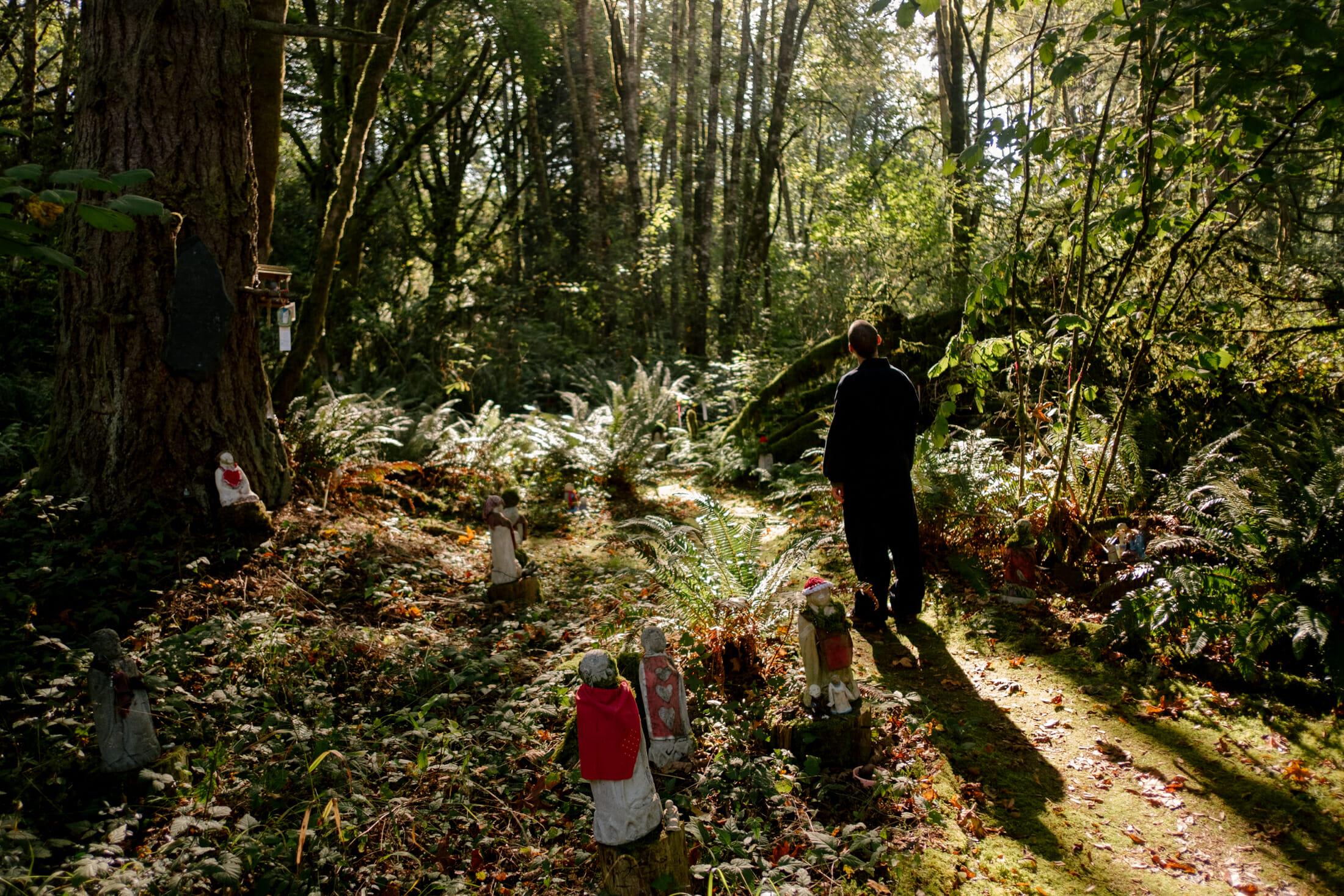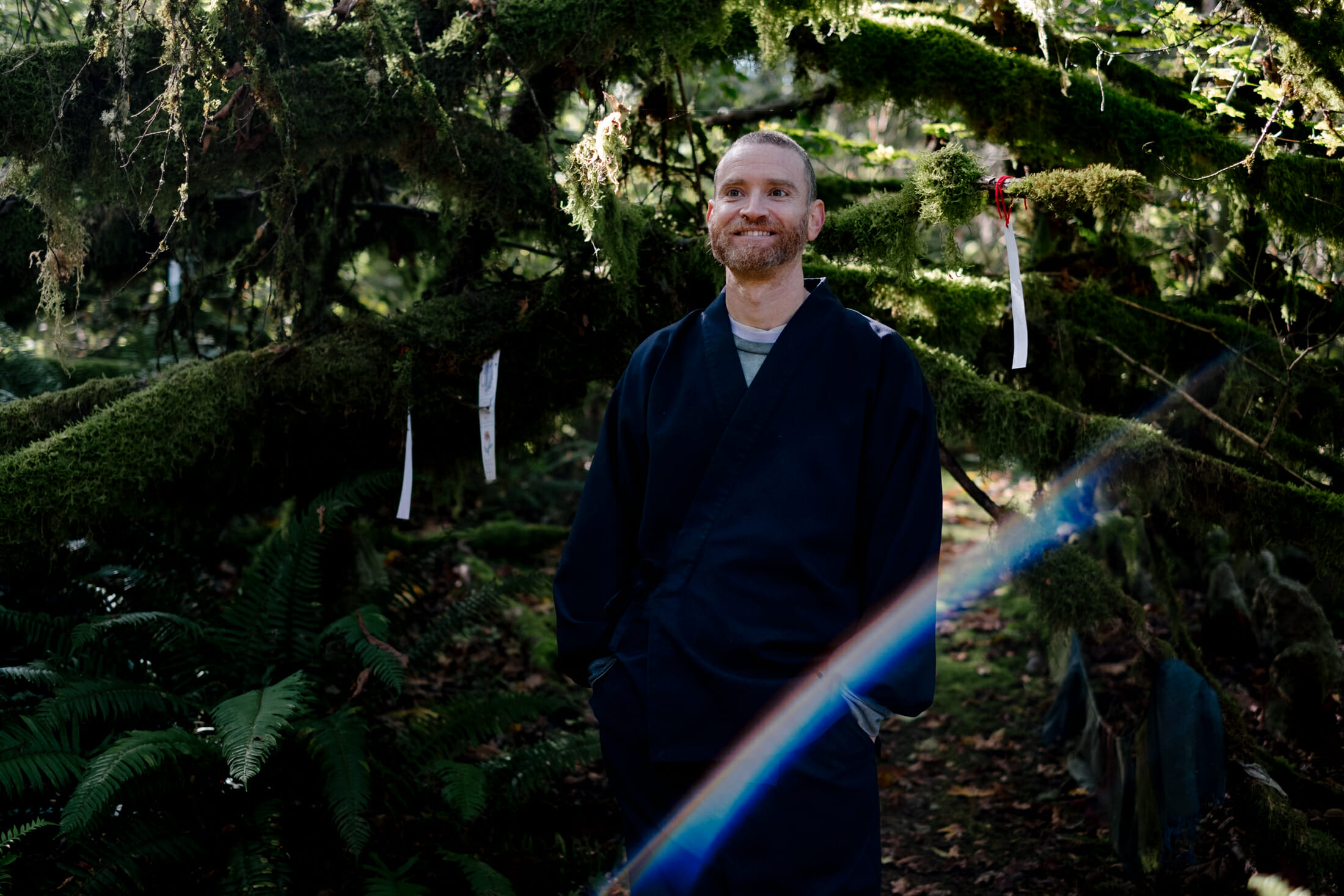Biography
Adam Jogen Salzberg is an ordained Zen Buddhist teacher with Dharma Transmission from Jan Chozen Bays, Roshi in the Soto Zen lineage. He has practiced meditation for 25 years including 15 years of full time residential practice and study at Great Vow Zen Monastery. Four years of that time was spent in intensive silent meditation retreat. In addition to his Zen training, he has also trained in Voice Dialogue, Process Work, Dzogchen and the ParaTheatre medium of Antero Alli.
Since 2007 Jogen has taught meditation, led retreats and worked with students face to face. Through SolisLuna, he works one-on-one with clients, bringing the non-dual awareness practices of Zen and Dzogchen together with Voice Dialogue parts work integrating Waking Up, Growing Up and Cleaning Up.
Background
Jogen, raised in a non-religious Jewish family, discovered his first taste of meditation in childhood during taekwondo classes. His family’s observance of Jewish holidays was minimal, with the exception of his grandfather, who secretly practiced meditation. Jogen’s deeper exploration into meditation began after his grandfather’s passing, when he inherited books on yoga, Zen, and a meditation device. Intrigued, he found solace and presence for the first time, alleviating the anxiety he had carried since his father’s death when he was seven.
The early loss deeply impacted his family, creating a sense of sorrow and fragmentation. Jogen’s encounter with Buddhism later in life resonated with him, offering an affirmation of life’s difficulties that he could trust, given his early experiences with impermanence and loss. Enthusiastically embracing meditation, he faced both frustration and exhilaration during his early attempts, often throwing a kitchen timer in frustration. Concurrently, he experimented with psychedelics, finding them helpful in breaking free from fixed states of mind.
As Jogen delved deeper into meditation, attending sitting groups and temples, he became increasingly drawn to retreats. The more he practiced, the more he desired to continue his meditative journey.
Advice
Jogen emphasizes the significance of intellectual training in Buddhist practice, recognizing that his normal thought processes often misalign with reality. He stresses the importance of studying and training the mind to gain clarity and discernment, viewing it as a crucial aspect of Buddhist practice. However, he cautions that intellectual understanding alone is insufficient for liberation.
According to Jogen, true transformation involves two components: deep attention training and cultivating a loving heart. He highlights the non-duality of body and mind in Japanese Buddhism, rejecting the Western Cartesian split between mind and matter. Jogen shares his personal struggle with feeling disembodied during meditation and advocates for an integrated approach where awareness and the body are perceived as one.
For him, the challenge lies in overcoming the tendency to view awareness as a separate, transcendent entity. Instead, he encourages a holistic perspective where awareness permeates the entire body. Jogen acknowledges the ongoing work he undertakes to align his practice with this understanding, addressing bodily holding, trauma, and undigested emotions. He underscores the necessity of embracing this integrated approach and avoiding the pitfall of seeking refuge solely in transcendent awareness, acknowledging that the impulse to bypass this connection is deeply ingrained.
Creative Expression
Jogen explores the integration of meditation into daily life, considering the origin and depth of his actions. He reflects on whether his activities arise from a reactive and anxious self or from a deeper, more compassionate nature like bodhichitta. Throughout his practice, he has learned to include diverse expressions in his understanding of Dharma, recognizing that every shape holds wisdom and beauty.
In his exploration, Jogen incorporates his love for music into his practice, playing the drum set and participating in a monastery marimba band. He emphasizes the importance of relaxation and cultivating a spacious, not-knowing mind, allowing surprising rhythms to emerge. Jogen also engages in sound and listening meditation, blending music for others in a sitting meditation setting. He sees experimentation as valuable within the context of rooted traditional methods, finding joy in exploring new ways to connect with meditation in the modern era.
Immersion
Jogen reflects on his 16 years of living in a spiritual community, acknowledging the challenges and rewards of communal living. Despite occasional difficulties arising from diverse backgrounds and personalities, he values the shared aspiration that brings people together. Living in a residential Sangha becomes a powerful mirror for his practice, revealing the state of his mind and the openness of his heart through daily interactions.
Jogen highlights the transformative nature of living with challenging individuals, recognizing them as blessings that unveil his own shadows and projections. He emphasizes the learning process of getting along with others and understanding one’s reactions. On the positive side, intentional community living inspires him, creating a deep sense of friendship and camaraderie among those committed to Buddhist practice. The shared intention fosters meaningful conversations and a sense of spiritual peer pressure, a positive force that keeps practitioners aligned with their aspirations even during times of weakness. Jogen appreciates the supportive environment where fellow community members uplift and sustain one another on their spiritual journey.
Integration
Jogen reflects on his 16 years of living in a spiritual community, acknowledging the challenges and rewards of communal living. Despite occasional difficulties arising from diverse backgrounds and personalities, he values the shared aspiration that brings people together. Living in a residential Sangha becomes a powerful mirror for his practice, revealing the state of his mind and the openness of his heart through daily interactions.
Jogen highlights the transformative nature of living with challenging individuals, recognizing them as blessings that unveil his own shadows and projections. He emphasizes the learning process of getting along with others and understanding one’s reactions. On the positive side, intentional community living inspires him, creating a deep sense of friendship and camaraderie among those committed to Buddhist practice. The shared intention fosters meaningful conversations and a sense of spiritual peer pressure, a positive force that keeps practitioners aligned with their aspirations even during times of weakness. Jogen appreciates the supportive environment where fellow community members uplift and sustain one another on their spiritual journey.
Lineage
Jogen reflects on the impact of Suzuki Roshi’s book, “Beginner’s Mind,” which served as a revelation during his youth. Unlike other teachings that felt dogmatic, Suzuki Roshi’s approach encouraged Jogen to sit and rest in himself, discovering his true nature without imposing beliefs. The emphasis on intimate self-discovery and the intuitive revelation of Buddhist teachings resonated with Jogen, allowing him to explore Buddhism from the inside out.
In discussing the Zen lineage at the Zen Community of Oregon and the monastery, Jogen highlights the unique blend of Soto Zen and the White Plum lineage. The practice integrates traditional forms, ritual rhythms, chants, and body expressions, embodying the unity of body and mind as emphasized by Dogen, the founder of the Soto lineage in Japan. Dogen’s teachings, although challenging, serve as a touchstone and foundation, influencing the community.
Jogen introduces the Shakuntala practice, associated with the Soto School, as a form of meditation without a goal. This approach invites practitioners to sit as awareness, trusting that awakening exists fully in the present moment. The practice is not a means to an end but a simultaneous expression of both practice and awakening. It challenges individuals to discover the depth of the present moment, eschewing a gradual unfolding of meditation in favor of a direct exploration of reality.
Meditation Technology
Jogen acknowledges the potential benefits of meditation technology, citing his own positive experience with his grandfather’s light and sound meditation device. While he hasn’t personally used meditation apps, he recognizes their utility as a gateway or support for sustaining daily practice. However, he emphasizes the importance of Buddhist practice evolving beyond solitary engagement with technology. Jogen believes that, for the practice to mature, it must involve human relationships. He expresses a preference for in-person interactions, considering them essential for the depth of engagement with living beings and the Dharma, indicating a traditionalist perspective in valuing the ceremonial and communal aspects of Buddhist practice.
Refuge
Jogen reflects on his affinity for the Zen tradition, recounting his introduction to monastic life at the age of 22. He found the experience both challenging and inspiring, and the lineage resonated deeply with him. Trust played a pivotal role, as he followed his heart and embraced the teachings and history of the Zen tradition. For Jogen, the choice was driven by a sense of natural trust and a heart connection.
The commitment to a specific lineage and teacher became essential for Jogen, expressing a desire to go deep and soak up the teachings offered by Zen teachers. He emphasizes the importance of the teacher-student relationship and the need to give oneself fully to a tradition to truly understand its wisdom and heart. Jogen focused on Zen practice for around ten years, recognizing that unraveling the depth of a lineage requires time and dedication. He acknowledges the unfolding of the tradition’s offerings within his own being, highlighting the need for a sustained commitment to truly grasp the essence of a lineage.
Retreats
Jogen shares his extensive experience with meditation retreats, noting their transformative and challenging nature. He emphasizes the commitment and potency that arise when fully dedicating oneself to the practice, whether in solo retreats or in synergy with others. Drawing a parallel to mastering a musical instrument, he highlights the significance of sustained commitment and intimacy with the practice.
While Jogen recognizes the special circumstances and dynamic transformation within retreats, he questions their essential nature. Instead, he suggests that the transformative power of the practice lies in sustaining awareness throughout the day. Jogen shares personal experiences of how even brief formal sessions created a lasting afterglow that carried into daily activities, amplifying awareness and sensitivity.
Challenging the notion that retreats are essential, Jogen proposes that a committed and sustained engagement with the practice throughout the day can yield transformative results. He reflects on the organic unfolding of one’s relationship with the Dharma, likening retreats to a deepening commitment in a relationship. Jogen encourages practitioners to be creative and resourceful, adapting the practice to their lives, even in the absence of formal retreats. He underscores the power of commitment and engagement with the practice, regardless of the specific circumstances.
Teachers
Jogen reflects on his journey as a seeker, recounting how he met one of his teachers in Portland, experiencing a profound affinity and immediate trust. He emphasizes the teacher’s acceptance without judgment, a pivotal factor that allowed him to lean on the relationship for support. Jogen describes himself as fickle, distractible, and less courageous, contrasting this with the focused, faithful, and wise nature of his teacher. Having lived with his teachers for 16 years, he acknowledges their embodiment of kindness, skillfulness, and wisdom as inspiring, providing a steady commitment to practice.
In the context of deep dharma work, Jogen highlights the importance of exposing oneself to oneself and the challenge of dismantling the constructed sense of identity. He stresses the role of trust and love in the teacher-student relationship, creating a space for feedback and teachings to penetrate where self-deception may persist. Jogen finds the dismantling process scary and intimate, involving the recognition and unraveling of cherished beliefs and personality structures. He expresses gratitude for his teachers, who have not only guided him through this process but also held him during moments of crisis when personality structures melted, allowing for transformative dharma work to unfold.














































































